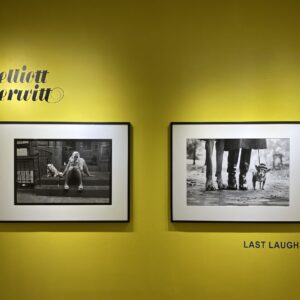JTF (just the facts): Published in 2024 by The Sand Station (here). Hardcover (22.5 x 29.8 cm), 108 pages, with 41 color photographs. Design by Amir Avraham. Islamic calligraphy by Mohamad Badenjki. In an edition of 1000 copies. (Cover and spread shots below.)
Comments/Context: In his practice, the Swiss artist Marwan Bassiouni hopes to contribute to a more balanced perspective of Muslim and Arab minorities by inviting viewers to participate in a dialogue. Born in Switzerland to an Egyptian father and American mother, Bassiouni never felt rooted in one place, and perceives the world through multiple perspectives. He is interested in the perception of the Muslim religion in Western society, and its representation or misrepresentation in Western culture.
While studying at the Royal Academy of Art in the Hague, he became fascinated by the experience of photographic looking, and in 2018 he began his series “New Western Views”, which takes as its subject outward looking views as seen from inside mosques in a number of Western countries. It presents two places at once, each hybrid view mixing two scenes: the interior of a mosque and the exterior view out of its windows. With this project, Bassiouni wants to document both the mosque interiors (where thousands of Muslims practice their faith) and the views they see looking outward from those sacred spaces. These interiors remain unfamiliar to (and separate from) the non-Muslims, while the landscape is a shared place. “I’m more interested in the similarities between a Muslim person and a non-Muslim person,” Bassiouni explains. “I want to look at people’s common ground rather than their differences.”
His most recent photobook is titled New Swiss Views, and as the title suggests, the book focuses on locations in Switzerland. New Swiss Views has a striking cover, with a photograph of a skylight with a chair positioned underneath it printed in burgundy ink on a blue cloth cover. The title is placed right in the center, in two lines, while the artist’s name appears on the carpet part of the image. The book opens to a bright peach colored endpaper. Inside, most of the photographs are generally placed on the right page, with a few wider views stretching across over the gutter. A short text and the list of captions, printed on a light paper, appear at the very end, closing the book. The book also easily lays flat making the interaction even more enjoyable.
Bassiouni sees photography as a construct, and says that “documentary” is “more about a will to engage with something that we consider to be collective reality.” He creates photographs using natural lighting and two exposures, one for inside and one for outside. He then digitally combines the images to produce a scene that corresponds as closely as possible to what appears in reality, with each element rendered in perfect exposure. In an interview with The New Yorker, he described his process as an act of portraiture, noting he is “photographing spaces that, in a way, have a soul.”
For this new project, Bassiouni visited the prayer rooms of Swiss mosques between August 2021 and November 2022 in sixteen cantons across the country, traveling “through mountains, lakes and countryside; and into the cities, suburbs and villages.” There are a total of 218 mosques and prayer rooms in the country (mostly not very visible, in backyards, former garages, industrial facilities, and other out-of-the-way locations), the second lowest number in comparison to the European average. A color version of the cover photograph opens the book, which is followed by a quote by Hasan Al-Basri, “Faith is not a matter of wishful thinking or outward appearance, rather it is what settles in the heart and is confirmed by one’s actions.”
The view from the windows typically shows various Swiss neighborhoods, and in some cases, wider landscapes. Inside, we usually see interior walls and windows, as well as carpet details, extra furniture, and decorative objects scattered around. As we look at one of the first images, we are immediately drawn to the window which faces a street scene, featuring a rounded corner of a building with ornate balconies, a stop sign, a bunch of locked bikes, and a pedestrian crossing with bright yellow lines. The mosque interior includes a white radiator under the window, a yellow chair, and a light blue carpet with an ornamental pattern. Often, the interiors of the mosques are generally pared down and simple, sometimes adorned with Islamic calligraphy, as seen on the walls, on prayer rugs, and on wall-to-wall carpets of various colors and ornaments. In comparison to the different scenes outside, a consistent sense of calmness and serenity is most common.
“These mosques aren’t in a Muslim country, they are here. In Switzerland, the Netherlands and England, and all over Europe,” Bassiouni says. With this series, he wanted to emphasize that they are part of these countries, part of the fabric of the communities in which they reside, even if they are often overlooked. Via his clever conceptual twist, Bassiouni has found an elegant way to tackle complex issues, offering us a different way of seeing something we might have missed. As a photobook object, New Swiss Views is thoughtful and beautifully produced, its attentiveness perhaps matching the reverence taking place in the many rooms the artist has visited.
Collector’s POV: Marwan Bassiouni does not appear to have gallery representation at this time. Interested collectors should likely follow up directly with the artist via his website (linked in the sidebar).

























